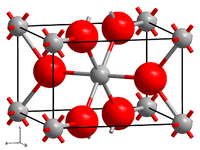Chromium(II) fluoride
 |
|
| Names | |
|---|---|
| Other names
chromium difluoride, chromium fluouride, chromous fluoride
|
|
| Identifiers | |
|
3D model (JSmol)
|
|
| ChemSpider | |
| ECHA InfoCard | 100.030.140 |
| EC Number | 233-168-0 |
|
PubChem CID
|
|
| UNII | |
|
|
|
|
| Properties | |
| CrF2 | |
| Molar mass | 89.99 g·mol−1 |
| Appearance | blue-green iridescent crystals hygroscopic, turns to Cr2O3 when heated in air |
| Density | 3.79 g/cm3 |
| Melting point | 894 °C (1,641 °F; 1,167 K) |
| Boiling point | > 1,300 °C (2,370 °F; 1,570 K) |
| 76.7 g/100 mL | |
| Structure | |
| monoclinic | |
| Thermochemistry | |
|
Std enthalpy of
formation (ΔfH |
-8.645 kJ/g (solid) |
| Hazards | |
|
EU classification (DSD) (outdated)
|
|
| R-phrases (outdated) | R20/21/22, R31, R34 |
| S-phrases (outdated) | S25, S26, S27/28, S36/37/39, S45 |
|
Except where otherwise noted, data are given for materials in their standard state (at 25 °C [77 °F], 100 kPa).
|
|
| Infobox references | |
Chromium(II) fluoride is an inorganic compound with the formula CrF2. It exists as a blue-green iridescent solid. Chromium(II) fluoride is sparingly soluble in water, almost insoluble in alcohol, and is soluble in boiling hydrochloric acid, but is not attacked by hot distilled sulfuric acid or nitric acid. Like other chromous compounds, chromium(II) fluoride is oxidized to chromium(III) oxide in air.
The compound is prepared by passing anhydrous hydrogen fluoride over anhydrous chromium(II) chloride. The reaction will proceed at room temperature but is typically heated to 100-200 °C to ensure completion:
Like many difluorides, CrF2 adopts a structure like rutile with octahedral molecular geometry about Cr(II) and trigonal geometry at F−. Two of the six Cr-F bonds are long at 2.43 Å, and four are short near 2.00 Å.
...
Wikipedia
